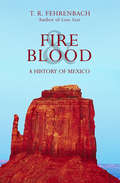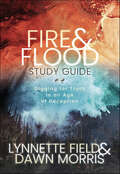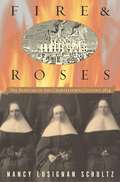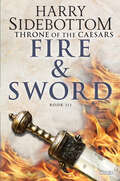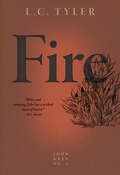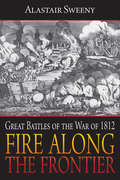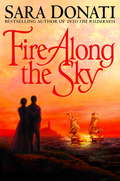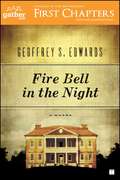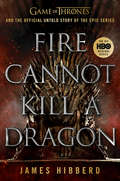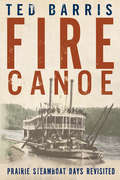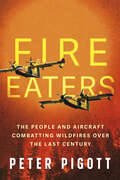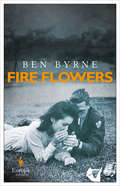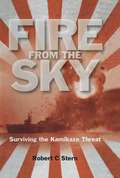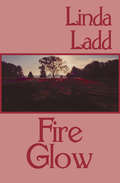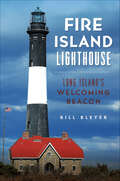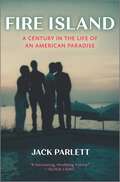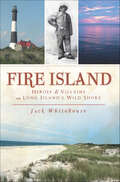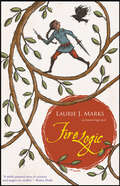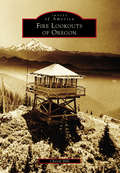- Table View
- List View
Fire
by Shohini GhoshA Queer Film Classic: the 1996 film by Indian-born director Deepa Mehta, about the burgeoning relationship between the wives of two brothers; its unprecedented lesbian themes led to riots outside cinemas in India.
Fire & Blood: A History of Mexico
by T. R. FehrenbachMexican history comes to life in this &“fascinating&” work by the author of Lone Star: A History of Texas and the Texans (The Christian Science Monitor).Fire & Blood brilliantly depicts the succession of tribes and societies that have variously called Mexico their home, their battleground, and their legacy. This is the tale of the indigenous people who forged from this rugged terrain a wide-ranging civilization; of the Olmec, Maya, Toltec, and Aztec dynasties, which exercised their sophisticated powers through bureaucracy and religion; of the Spanish conquistadors, whose arrival heralded death, disease, and a new vision of continental domination. Author T. R. Fehrenbach connects these threads with the story of modern-day, independent Mexico, a proud nation struggling to balance its traditions against opportunities that often seem tantalizingly out of reach. From the Mesoamerican empires to the Spanish Conquest and the Mexican Revolution, peopled by the legendary personalities of Mexican history—Montezuma, Cortés, Santa Anna, Juárez, Maximilian, Díaz, Pancho Villa, and Zapata—Fire & Blood is a &“deftly organized and well-researched&” work of popular history (Library Journal).
Fire & Blood: A History of Mexico
by T. R. FehrenbachMexican history comes to life in this &“fascinating&” work by the author of Lone Star: A History of Texas and the Texans (The Christian Science Monitor).Fire & Blood brilliantly depicts the succession of tribes and societies that have variously called Mexico their home, their battleground, and their legacy. This is the tale of the indigenous people who forged from this rugged terrain a wide-ranging civilization; of the Olmec, Maya, Toltec, and Aztec dynasties, which exercised their sophisticated powers through bureaucracy and religion; of the Spanish conquistadors, whose arrival heralded death, disease, and a new vision of continental domination. Author T. R. Fehrenbach connects these threads with the story of modern-day, independent Mexico, a proud nation struggling to balance its traditions against opportunities that often seem tantalizingly out of reach. From the Mesoamerican empires to the Spanish Conquest and the Mexican Revolution, peopled by the legendary personalities of Mexican history—Montezuma, Cortés, Santa Anna, Juárez, Maximilian, Díaz, Pancho Villa, and Zapata—Fire & Blood is a &“deftly organized and well-researched&” work of popular history (Library Journal).
Fire & Flood Study Guide: Digging for Truth in an Age of Deception
by Lynnette FieldTwo young women encounter God in pivotal, historical moments—one in the beginning, at the time of the Great Flood, and another at the end, during the Great Tribulation—and draw closer to Him as they watch prophecy unfold.Fire & Flood by Dawn Morris is a fictional, historical, and futuristic story that challenges readers to discuss and research the many biblical topics it addresses—from interpreting biblical eschatology and prophecy and seeking peace in troubled times to finding salvation from sin and moving beyond the betrayal of false teachers, to investing in community outreach and trusting God’s sovereignty and purpose. Dawn Morris and Lynnette Field compiled Fire & Flood Study Guide: Digging for Truth in an Age of Deception to facilitate discussion within prayer groups and Bible studies for today’s seekers or believers. A perfect companion to Morris’ novel, this guide shows readers how to sort fact from fiction, how to find hope in God’s promises, and how to apply biblical principles to everyday life.
Fire & Roses: The Burning of the Charlestown Convent, 1834
by Nancy Lusignan SchultzIn the midst of a deadly heat wave during the summer of 1834, a woman clawed her way over the wall of a Roman Catholic convent near Boston, Massachusetts and escaped to the home of a neighbor, pleading for protection. When the bishop, Benedict Fenwick, persuaded her to return, rumors began swirling through the Yankee community and in the press that she was being held at the convent against her will, and had even been murdered. The imagined fate of the "Mysterious Lady," as she became popularly known, ultimately led to the destruction of the Ursuline convent in Charlestown, Massachusetts on the night of August 11, 1834 by a mob of Protestant men. After battering down the front door, the men destroyed icons, smashed pianos, hurled the bishop's library into a bonfire, ransacked the possessions of both sisters and students, and finally burned the imposing building to the ground. Not satisfied with this orgy of vandalism, they returned the following night and tore the lovely gardens up by the roots. The ruins sat on Mount Benedict, a hill overlooking Boston Harbor, for the next fifty years. The arsonists' ringleader, a brawny bricklayer named John Buzzell, became a folk hero. The nuns scattered, and their proud and feisty mother superior, Mary Anne Moffatt, who battled the working-class rioters and Church authorities, faded mysteriously into history. Nancy Schultz brings alive this forgotten moment in the American story, shedding light on one of the darkest incidents of religious persecution to be recorded in the New World. The result of painstaking archival research, Fire & Roses offers a rare lens on a time when independent, educated women were feared as much as immigrants and Catholics, and anti-Papist diatribes were the stuff of bestsellers and standing-room-only lectures. Schultz examines the imagined secrets that led to the riot and uncovers the real secrets in a cloistered community whose life was completely hidden from the world. She provides a glimpse into nineteenth-century Boston and into an elite boarding school for young women, mostly the daughters of wealthy Protestants, vividly dissecting the period's roiling tensions over class, gender, religion, ethnicity, and education. Although the roots of these conflicts were in the Puritan migration to America, it was ultimately the mob's perverse fantasies about cloistered women -- in an independent community -- that erupted in a combustible night of violence. By unearthing the buried truth and bringing alive these fascinating characters, Nancy Schultz tells a gripping story of prejudice and pride, courage and cowardice in early nineteenth-century America that not only restores a clouded chapter in the country's history but also has a poignant resonance for our own times.
Fire & Sword: Book Three (Throne of Caesars) (Throne of the Caesars #3)
by Harry SidebottomAncient Rome’s Emperor Maximinus faces wars and uprisings in this tale of political intrigue from the bestselling author of the Warrior of Rome novels.Blending heart-pounding action and historical accuracy, Harry Sidebottom’s bestselling Warrior of Rome series took readers from the shouts of the battlefield to the whisperings of the emperor’s inner circle. In this second book of his new Throne of the Caesars series, Sidebottom continues his retelling of one of the bloodiest periods of Roman history—the Year of the Six Emperors. In Rome in the year 238 AD, Emperor Maximinus’s reign hangs in the balance. The empire is bleeding manpower and money in order to sustain its wars in the north, and rebellions flare in the far reaches of its territories. Meanwhile in Africa, Gordian the Elder and Younger are proclaimed as the new Augusti. A family descending from the Imperial bloodline, they represent a chance for the establishment to take back the empire. The first blood of the revolt is shed in Rome when an assassin murders the emperor’s prefect, announcing to Rome that the Gordians have taken the throne; still bitter at Maximinus’s rise from the barracks to power, the Senate endorses the rebellion, and chaos descends on the capitol. But in his heart, Maximinus is a man of war: when he hears of the betrayal, he acts with decisive brutality and violence. On the dusty plains outside Carthage, blood and steel will determine the fate of the Roman Empire . . . Praise for Blood & Steel“Swashbuckling as well as bloody, yet curiously plausible . . . Best of all [Sidebottom] has a real gift for summoning up a sense of place, and conveying the sheer vastness of the Roman empire and its implications.” —Times Literary Supplement“Sidebottom continues his “Throne of the Caesars” series . . . with his new novel, Blood & Steel, and reading the intense drama he crafts out of the tumultuous events of the Roman Empire in AD 238 is a reminder that we’re lucky to have these books. . . . This is an era of Roman history for which we have less reliable primary source histories than we’d like; it’s the perfect playground for a novelist, and it’s found a superb dramatist.” —Open Letters Monthly
Fire (The John Grey Mysteries)
by L.C. TylerIt&’s the Autumn of 1666, and the Great Fire is still burning, the ashes of hundreds of houses and shops and St. Paul&’s Cathedral choking the air. The people, too, are choking, raging at the French, the Dutch, at the foreigners who—they are certain—lit the torch. Lord Arlington, the Secretary of State, might conceivably be interested in harnessing this anger; it can be so useful, at times, to have the population united in loathing of a common enemy. But this is not one of those times. And inconveniently, a Frenchman—clearly an insane Frenchman—has confessed to setting the fire. He did it with an accomplice, he says. And he subsequently killed the accomplice. It&’s all most irritating for Arlington, or it would be if he didn&’t have John Grey on call. Go poke around the smoldering ruins, Arlington says. Find me a convenient fall guy. Make this problem go away.
Fire Along the Frontier: Great Battles of the War of 1812
by Alastair SweenyA view of the War of 1812 from a social perspective. This book provides a fresh new view of the battles of the war and goes behind the scenes to explore wartime trading activity, particularly American dealings with Napoleon and cross-border commerce, as well as the activities of John Jacob Astor, America’s richest man and war financier, and his fur-trading partners in Montreal.There was a wealth of military screw-ups. What did the generals do before each battle to lose it, and what could they have done to win? And did the incompetence and mixed loyalties of Military Governor Sir George Prevost, grandson of a financier of the American Revolution and nephew by marriage of Vice President Aaron Burr, nearly lose Canada for the British?The book also provides glimpses of some of the fascinating behind-the-scenes players, such as legendary but flawed President Thomas Jefferson, and President Madison’s wife, Dolley, who could have won the war single-handedly had she been able to get all the generals together in the same drawing room.
Fire Along the Sky (Wilderness, Book #4)
by Sara DonatiWith epic sweep and breathtaking adventure, Sara Donati's bestselling saga of an Early American family's struggle for survival in the Northeast wilderness continues with the story of an indomitable woman and an unforgettable journey of redemption across a young nation threatened by the flames of war. The year is 1812 and Hannah Bonner has returned to her family's mountain cabin in Paradise. But Nathaniel and Elizabeth Bonner can see that Hannah is not the same woman as when she left.
Fire Angels: A Novel
by Elizabeth KernThis “heartbreakingly engrossing” novel explores the true events surrounding the Our Lady of the Angels school fire in 1958 Chicago (Foreword Reviews).Three weeks before Christmas, on December 1, 1958, one of the most horrific fires in American history broke out at Our Lady of the Angels elementary school in Chicago, claiming the lives of ninety-two children and three nuns. Fire Angels is a fictional account of that fire. It’s a story of arson; of bravery by parents, nuns, firefighters, and medical professionals; of a falsely accused janitor; of a cover-up within the Catholic Church; of a judge who, in having to determine the juvenile arsonist’s fate, is torn between loyalty to his church and justice; of a tight-knit community changed forever; and of two survivors who fall in love. Fire itself is also a central character in this story, a cunning observer that comes to life whenever a flame is lit.
Fire Base Illingworth: An Epic True Story of Remarkable Courage Against Staggering Odds
by Philip Keith“[A] propulsive history of American soldiers under siege in the last days of the Vietnam War” from the award-winning author of Blackhorse Riders (Kirkus Reviews).In the early morning hours of April 1, 1970, more than four hundred North Vietnamese soldiers charged out into the open and tried to over-run FSB Illingworth. The battle went on, mostly in the dark, for hours. Exposed ammunition canisters were hit and blew up, causing a thunderous explosion inside the FSB that left dust so thick it jammed the hand-held weapons of the GIs. Much of the combat was hand-to-hand. In all, twenty-four Americans lost their lives and another fifty-four were wounded. Nearly one hundred enemy bodies were recovered. It was one of the most vicious small unit firefights in the history of US forces in Vietnam.As in his acclaimed book Blackhorse Riders, a finalist for the prestigious Colby Award, Phil Keith uncovers a harrowing true story of bravery and sacrifice by the men who fought valiantly to hold FSB Illingworth—a tale never-before-told and one that will not be soon forgotten."A harrowing tale that centers on an exhausted, ragtag group of U.S. Army troops as they fought for their lives against a 400-man North Vietnamese Army regiment in a vicious engagement in 1970 . . . The heart of the book is a virtually minute-by-minute description of the fighting." —Publishers Weekly
Fire Bell in the Night
by Geoffrey EdwardsFilled with historic details of the time, Fire Bell in the Night explores the explosive tension between North and South, black and white, that gripped Charleston, South Carolina, in the summer of 1850. Geoffrey S. Edwards's first novel tells the story of New York Tribune reporter John Sharp, sent to cover the capital trial of Darcy Calhoun, a farmer who stands accused of harboring a fugitive slave. As the trial begins, John quickly realizes that not everything is as it appears in the genteel city of Charleston. A series of mysterious fires in white establishments brings the state militia, a curfew for the black population, and rising tension at the courthouse. To unravel the city's secrets, Sharp must enter Charleston's plantation society, where he is befriended by Tyler Breckenridge, owner of the Willowby plantation, and his beautiful sister Clio. Set against the backdrop of a nation headed toward civil war, Fire Bell in the Night is a page-turning account of a trial and one young reporter's efforts to discover the truth.
Fire Cannot Kill a Dragon: Game of Thrones and the Official Untold Story of the Epic Series
by James HibberdPraise from George R.R. Martin: "James Hibberd covered Game of Thrones from start to finish, and he knows where all the bodies are buried. It's all here, in his oral history of the series: how it began, how it ended, dragons and direwolves, what went on in front of the cameras and what went on behind the scenes, the triumphs and the stumbles, the tough decisions, the forks in the road, the reasons why. Actors, directors, showrunners, producers, executives, even me... Fire Cannot Kill a Dragon has it all, everything you ever wanted to know. Game of Thrones was an amazing ride. Fire Cannot Kill a Dragon is an amazing read.&” The official, definitive oral history of the blockbuster show from Entertainment Weekly&’s James Hibberd. It was supposed to be impossible. George R.R. Martin was a frustrated television writer who created his bestselling A Song of Ice and Fire fantasy novels to be an unfilmable saga bound only by the limits of his vast imagination. Then a pair of first-time TV writers teamed with HBO to try and adapt Martin&’s epic. We&’ve all seen the eight seasons of the Emmy-winning fantasy series that came next. But there is one Game of Thrones tale that has yet to be told: the 13-year behind-the-scenes struggle to pull off this extraordinary phenomenon. In Fire Cannot Kill a Dragon, award-winning Entertainment Weekly writer James Hibberd chronicles the untold and uncensored story of Game of Thrones, from the creative team&’s first meetings to staging the series finale and all the on-camera battles and off-camera struggles in between. The book draws from more than 50 revealing new interviews, rare and stunning photos, and unprecedented access to the producers, cast, and crew who took an impossible idea and made it into the biggest show in the world.
Fire Canoe: Prairie Steamboat Days Revisited
by Ted BarrisThe story of steamboating in the Canadian West comes to life in the voices of those aboard the vessels of the waterways of the Prairies. Their captains were seafaring skippers who had migrated inland. Their pilots were indigenous people who could read the shoals, sandbars, and currents of Prairie waterways. Their operators were businessmen hoping to reap the benefits of commercial enterprise along the shores and banks of Canada’s inland lakes and rivers. Their passengers were fur traders, adventure-seekers, and immigrants opening up the West. All of them sought their futures and fortunes aboard Prairie steamboats, decades before the railways arrived and took credit for the breakthrough. Aboriginal people called them “fire canoes,” but in the latter half of the nineteenth century, their operators promoted them as Mississippi-type steamship queens delivering speedy transport, along with the latest in technology and comfort. Then, as the twentieth century dawned, steamboats and their operators adapted. They launched smaller, more tailored steamers and focused on a new economy of business and pleasure in the West. By day their steamboats chased freight, fish, lumber, iron ore, real estate, and gold-mining contracts. At night, they brought out the Edwardian finery, lights, and music to tap the pleasure-cruise market.
Fire Eaters: The People and Aircraft Combatting Wildfires Over the Last Century
by Peter PigottThe riveting history of how aircraft have transformed the fighting of wildfires. Throughout history, when threatened by wildfires our only defense was to pray for rain and run — until aircraft changed the way we fight fires. Beginning with the Canadian “H-Boats” in 1924, aircraft have become indispensable in detecting and extinguishing wildfires. Fire Eaters tells the incredible stories of the Ontario Provincial Air Service, the first government aerial fire suppression organization in history; one of its pilots, Carl Crossley, who invented the water scoop-up and drop-off system; and the Canadair CL-215, the first purpose-built water bomber. Today, helicopters with “Bambi Buckets” and snorkels can dump water while hovering directly over the flames, and Air Tractors and Dash 8-400AT air tankers not only perform a crucial role in saving communities but also protect our ecosystem. Satellites — unmanned aircraft able to fly for sixteen hours, even overnight when manned aircraft do not — and artificial intelligence already play a decisive role in fire management. But it is the men and women of the aerial fire service who have really changed the way we fight fire around the world. Their bravery and dedication mean that response times are fast, fires can be contained sooner, and people have the chance to save rather than lose everything.
Fire Flowers
by Ben ByrneIn this &“promising literary debut,&” three Japanese citizens and one American reporter rebuild their lives in the aftermath of Japan&’s WWII surrender (The Independent). Japan, 1945. The country has just surrendered to the Allied forces after suffering the devastation of nuclear warfare. Satsuko Takara and her teenage brother, Hiroshi, have lost both their parents, and each other, during the firestorm that devastated Tokyo five months before. Documenting the destruction of the war is Hal Lynch, a haunted US photojournalist, who stumbles upon a shocking story and is determined to bring it to light. And Osamu Maruki, a dissolute writer and once Satsuko&’s lover, has returned from the South Pacific a broken and changed man. The war-torn streets of Tokyo come alive in this dazzlingly observed debut novel as the lives of these former enemies come together. Fire Flowers powerfully portrays the shock, the struggles, and the difficult choices that arise from the destruction of war. &“An impressive and nuanced account of a dark moment in history.&” —The Independent
Fire From the Sky: Surviving the Kamikaze Threat
by Robert C. StemBy late 1944 the war in the Pacific had turned decisively against the Japanese, and overwhelming Allied forces began to close in on the home islands. At this point Japan unveiled a terrifying new tactic: the suicide attack, or Kamikaze, named after the Divine Wind which had once before, in medieval times, saved Japan from invasion. Intentionally crashing bomb-laden aircraft into Allied warships, these piloted guided missiles at first seemed unstoppable, calling into question the naval strategy on which the whole war effort was based.This book looks at the origins of the campaign, at its strategic goals, the organization of the Japanese special attack forces, and the culture that made suicide not just acceptable, but honourable. Inevitably, much mythology has grown up around the subject, and the book attempts to sort the wheat from the chaff. One story that does stand up is the reported massive stock-piling of kamikaze aircraft for use against any Allied invasion of the home islands, if the atomic bombs had not forced Japans surrender.However, its principal focus is on the experience of those in the Allied fleets on the receiving end of this peculiarly alien and unnerving weapon how they learnt to endure and eventually counter a threat whose potential was over-estimated, by both sides. In this respect, it has a very modern resonance.
Fire Glow
by Linda LaddA battle of wills between an 18th-century pirate and her captor stirs up the high seas in this historical Caribbean romance from the award-winning author. Beneath the fiery gaze of her captor, Caitlin finds herself bound by the only enemy she could not defeat—her passionate nature. Caitlin, the renegade female pirate plundering Spanish galleons on the high seas, initially despised Trey Cameron, the man commissioned by the queen to tame her. As he forces her to conform to an appropriately feminine role, wearing gowns and performing the tasks of housekeeper, Caitlin vows to avenge herself. She will rule the waves again . . . free of the restraining hand of any man. As the lush green of the Caribbean brings them to tumult, Trey and Caitlin find themselves locked in a fiery battle of wills. Will they surrender to the refuge of each other's arms—or tear each other apart in the frustration of unrequited love?
Fire Island
by Shoshanna MccollumThe birth of Fire Island's modern era may well be the day it was declared a national seashore--September 11, 1964. From this day on, the barrier island would remain forever persevered under custody of the National Park Service. Today, automobiles are the exception, not the rule, thanks to men and women who fought to prevent a paved highway from being constructed on the barrier island over 50 years ago. The island's culture has always embraced its own distinct path. Fire Island's maritime roots are still evident and alternate lifestyles flourish, while the simple and mundane pleasures of a beautiful day at the beach remain intact. Fire Island continues to spark the imagination of tourists, vacationers, and residents alike who revel in the beauty of this unique place. Today, Fire Island is so many things to so many people.
Fire Island Lighthouse: Long Island's Welcoming Beacon (Landmarks)
by Bill BleyerThe first Fire Island Lighthouse was constructed in 1826 after numerous shipwrecks along the barrier island. A replacement tower built in 1858 incorporated innovations in lighthouse design such as the Fresnel lens. Vessels anchored offshore, known as lightships, augmented the lighthouse for many years. The Coast Guard shut down the site in 1973. Through the efforts of the Fire Island Lighthouse Preservation Society and the National Park Service, the beautiful structure was meticulously restored and the tower relit in 1986. Along with a selection of wonderful color photographs depicting the grandeur of the lighthouse, author Bill Bleyer charts the history of Long Island's cherished Fire Island Lighthouse.
Fire Island: A Century in the Life of an American Paradise
by Jack Parlett*A Washington Post &“Book to Read This Summer&”**AN ADVOCATE BEST LGBTQ+ BOOK OF 2022*A groundbreaking account of New York's Fire Island, chronicling its influence on art, literature, culture and queer liberation over the past centuryFire Island, a thin strip of beach off the Long Island coast, has long been a vital space in the queer history of America. Both utopian and exclusionary, healing and destructive, the island is a locus of contradictions, all of which coalesce against a stunning ocean backdrop.Now, poet and scholar Jack Parlett tells the story of this iconic destination—its history, its meaning and its cultural significance—told through the lens of the artists and creators who sought refuge on its shores. Together, figures as divergent as Walt Whitman, Oscar Wilde, James Baldwin, Carson McCullers, Frank O'Hara, Patricia Highsmith and Jeremy O. Harris tell the story of a queer space in constant evolution.Transporting, impeccably researched and gorgeously written, Fire Island is the definitive book on an iconic American destination and an essential contribution to queer history.
Fire Island: Heroes & Villains on Long Island's Wild Shore
by Jack WhitehouseFire Island, or Great South Beach as it is also known, is a 32-mile long sliver of a barrier beach located just off the South Shore of Long Island. Always a wild, lonely and untamed wilderness, its shores, waterways and the lands surrounding it have given us innumerable stories -- some inspirational, some frightening, but all of them intriguing. The stories in this book portray people and events from the island's earliest days, when it served Native Americans as a rich hunting, fishing and whaling site until the present day and its use as a U.S. National Seashore and National Wilderness Area.
Fire Logic
by Laurie J. Marks"Beautifully written."-Publishers Weekly, starred reviewThe martial Sainnites have occupied Shaftal for fifteen years. Every year the cost of resistance rises. Emil, an officer and scholar; Zanja, a diplomat and last survivor of her people; and Karis, a metalsmith, half-blood giant, and an addict, can only watch as their country falls into lawlessness and famine. Together, perhaps they can change the course of history.Laurie J. Marks' first two Elemental Logic novels (Fire Logic and Earth Logic) both won the Gaylactic Spectrum Award and received multiple starred reviews. She lives in Boston, Massachusetts, and teaches at the University of Massachusetts.
Fire Lookouts of Glacier National Park
by David R. ButlerThe first fire lookouts in the Glacier National Park region were simply high points atop mountain peaks with unimpeded views of the surrounding terrain. Widespread fires in the 1910s and 1920s led to the construction of more permanent lookouts, first as wooden pole structures and subsequently as a variety of one- and two-story cabin designs. Cooperating lookouts in Glacier Park, the Flathead National Forest, and the Blackfeet Indian Reservation provided coverage of forests throughout Glacier National Park. Beginning in the 1950s, many of the lookouts were decommissioned and eventually destroyed. This volume tells the story of the rise and fall of the extensive fire lookout network that protected Glacier National Park during times of high fire danger, including lookouts still operating today.
Fire Lookouts of Oregon (Images of America)
by Cheryl HillThe first lookouts were rustic camps on mountaintops, where men and women were stationed to keep an eye out for wildfires. As the importance of fire prevention grew, a lookout construction boom resulted in hundreds of cabins and towers being built on Oregon's high points. When aircraft and cameras became more cost-effective and efficient methods of fire detection, many old lookouts were abandoned or removed. Of the many hundreds of lookouts built in Oregon over the past 100 years, less than 175 remain, and only about half of these are still manned. However, some lookouts are being repurposed as rental cabins, and volunteers are constantly working to save endangered lookouts. This book tells the story of Oregon's fire lookouts, from their heyday to their decline, and of the effort to save the ones that are left.

